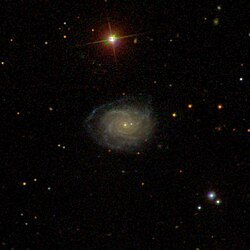NGC 7601
| Galaxie NGC 7601 | |
|---|---|
 | |
| SDSS-Aufnahme | |
| AladinLite | |
| Sternbild | Pegasus |
| Position Äquinoktium: J2000.0, Epoche: J2000.0 | |
| Rektaszension | 23h 18m 47,0s [1] |
| Deklination | +09° 14′ 01″ [1] |
| Erscheinungsbild | |
| Morphologischer Typ | SAB(s)c[1] |
| Helligkeit (visuell) | 13,8 mag[2] |
| Helligkeit (B-Band) | 14,6 mag[2] |
| Winkelausdehnung | 1,1′ × 0,9′[2] |
| Positionswinkel | 96°[2] |
| Flächenhelligkeit | 13,6 mag/arcmin²[2] |
| Physikalische Daten | |
| Rotverschiebung | 0,026812 ± 0,000033[1] |
| Radialgeschwindigkeit | (8038 ± 10) km/s[1] |
| Hubbledistanz H0 = 73 km/(s • Mpc) | (366 ± 26) · 106 Lj (112,2 ± 7,9) Mpc [1] |
| Geschichte | |
| Entdeckung | Andrew Ainslie Common |
| Entdeckungsdatum | 4. August 1880 |
| Katalogbezeichnungen | |
| NGC 7601 • UGC 12487 • PGC 71022 • CGCG 406-056 • MCG +01-59-039 • 2MASX J23184710+0914010 • | |
NGC 7601 ist eine Balken-Spiralgalaxie vom Hubble-Typ SBcd im Sternbild Pegasus am Nordsternhimmel, die schätzungsweise 366 Millionen Lichtjahre von der Milchstraße entfernt ist.
Entdeckt wurde das Objekt am 4. August 1880 vom britischen Astronomen Andrew Ainslie Common.[3]
Einzelnachweise
Auf dieser Seite verwendete Medien
Autor/Urheber: Sloan Digital Sky Survey, Lizenz: CC BY 4.0

Angle of view: 4' × 4' (0.3" per pixel), north is up.
Details on the image processing pipeline: https://www.sdss.org/dr14/imaging/jpg-images-on-skyserver/